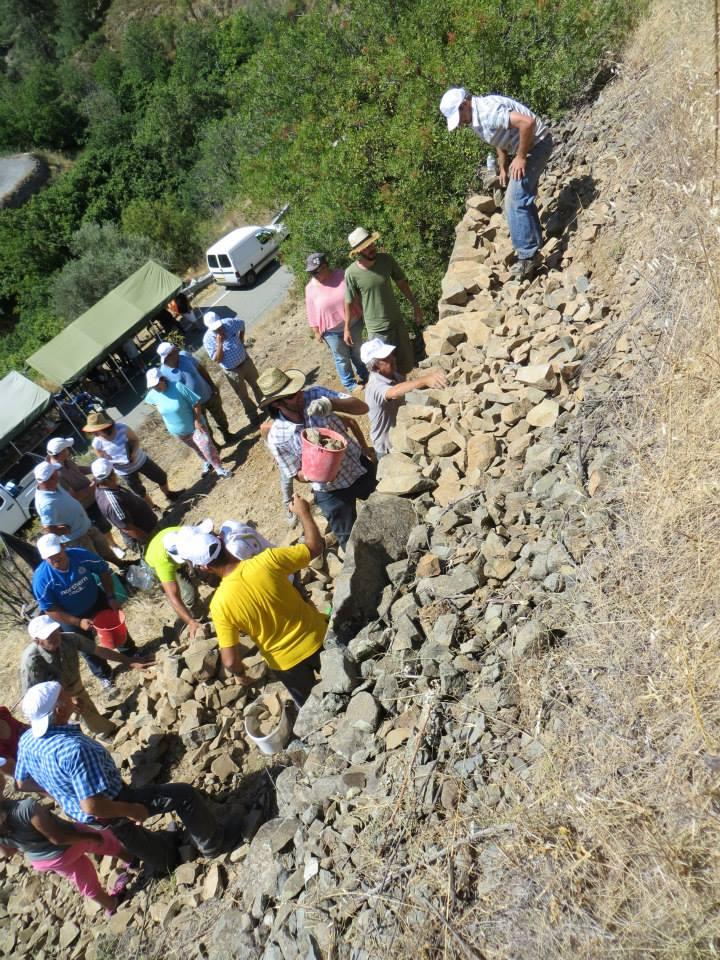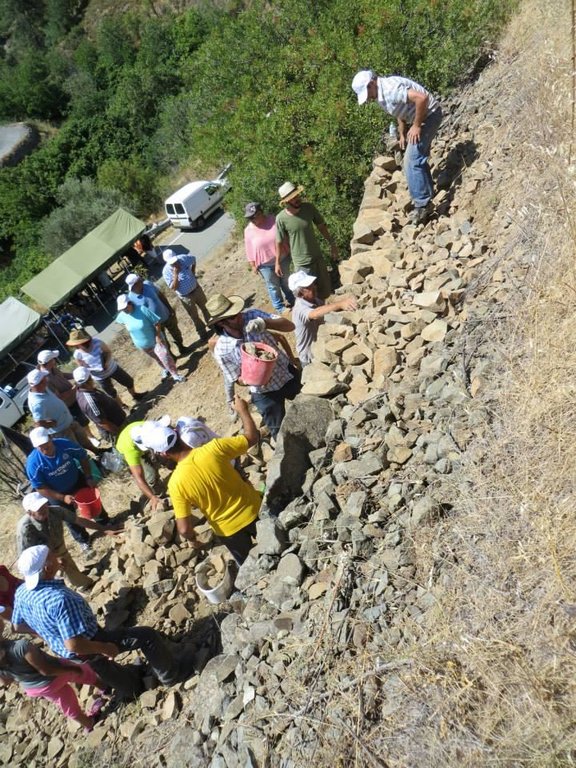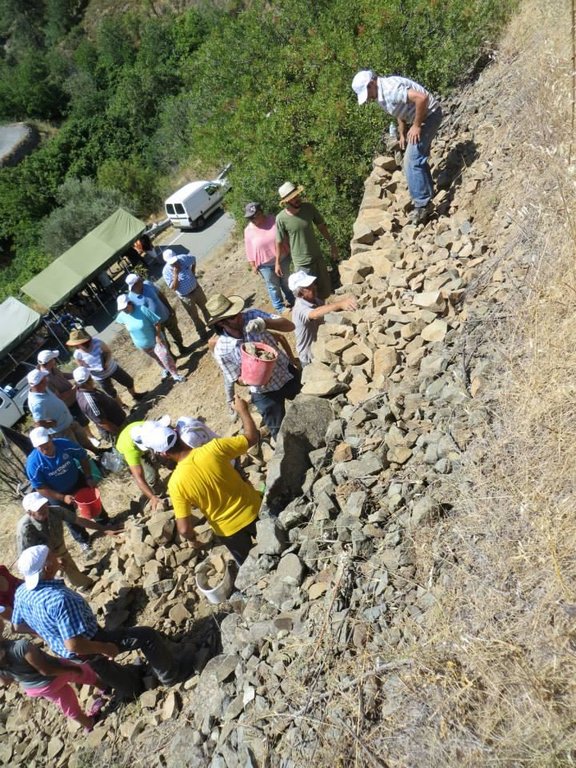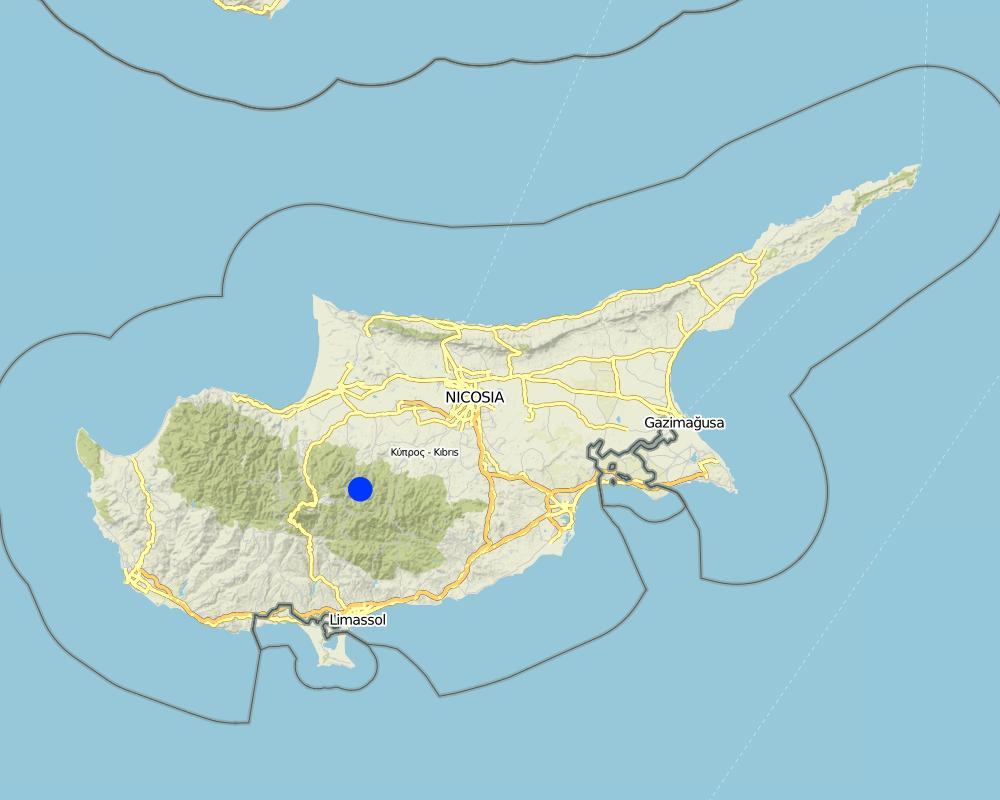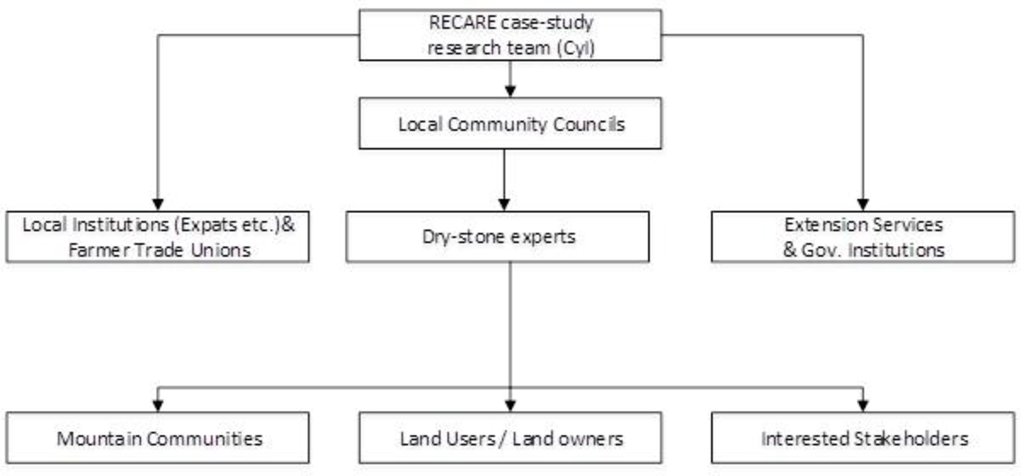Community-based maintenance and rehabilitation of agricultural terraces in mountain environments [塞浦路斯]
- 创建:
- 更新:
- 编制者: Christos Zoumides
- 编辑者: –
- 审查者: Fabian Ottiger
Κοινοτική συμμέτοχη για συντήρηση και αποκατάσταση ορεινών γεωργικών αναβαθμίδων (Greek)
approaches_2537 - 塞浦路斯
查看章节
全部展开 全部收起1. 一般信息
1.2 参与方法评估和文件编制的资源人员和机构的联系方式
SLM专业人员:
Burggemann Adriana
The Cyprus Institute
Nicosia
塞浦路斯
有助于对方法进行记录/评估的项目名称(如相关)
Preventing and Remediating degradation of soils in Europe through Land Care (EU-RECARE )有助于对方法进行记录/评估的机构名称(如相关)
The Cyprus Institute (The Cyprus Institute) - 塞浦路斯1.3 关于使用通过WOCAT记录的数据的条件
(现场)数据是什么时候汇编的?:
01/09/2015
编制者和关键资源人员接受有关使用通过WOCAT记录数据的条件。:
是
1.4 SLM技术问卷的参考
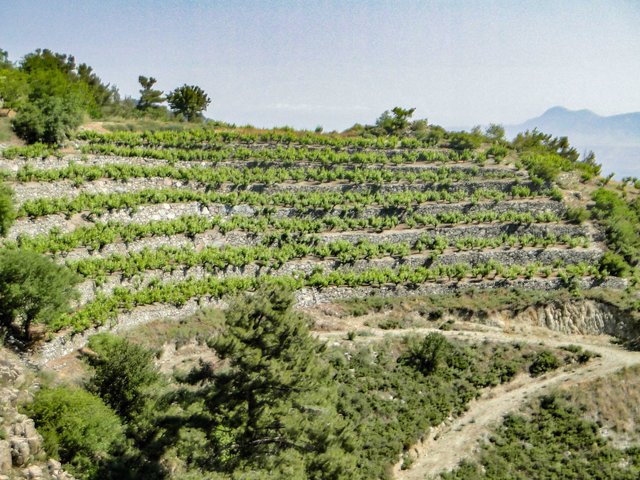
Agricultural terraces with dry-stone walls [塞浦路斯]
Dry-stone terraces built to create agricultural land, minimise soil erosion and retain soil moisture on steep mountain slopes.
- 编制者: Christos Zoumides
2. SLM方法的描述
2.1 该方法的简要说明
Maintenance and rehabilitation of traditional dry-stone terrace walls for agricultural use, through science-society cooperation, community engagement and motivation, and assistance to land users.
2.2 该方法的详细说明
该方法的详细说明:
Aims / objectives: The main objective of the approach is the restoration and rehabilitation of traditional dry-stone terraces in Mediterranean mountain environments. Large areas around mountain communities have been converted to agricultural terraces. The depopulation of these rural mountain communities and the high farming costs have led to the gradual reduction of farming activities. Consequently, many of the mountain terraces are no longer cultivated and dry-stone walls are not well maintained, causing a domino effect of collapsing terraces. Soil erosion by water has been identified as the main soil threat in degraded and poorly vegetated terraces.
The approach has been developed by the Cyprus Institute research team and aims at motivating the mountain communities, land users/owners, local institutions and other interested stakeholders to better organise themselves and collaborate and join forces in maintaining these terraces.
Methods: The approach is based on participatory principles. More precisely, the science-society cooperation approach is materialised through the organization of practical (hands-on) public events, where dry-stone experts guide the participants, land users/owners, local population, expats (families that have moved to the urban areas) and scientific stakeholders, in collectively maintaining collapsed and/or poorly maintained terraces. All parties engaged in the implementation of the approach on voluntary basis.
Stages of implementation: A pool of local and external stakeholders was prepared by the research team using snowball sampling. Key stakeholders identified include community leaders, land users/owners, dry-stone experts, local institutions, agricultural extension services and farmer unions.
Leaders of the three mountain communities agreed to co-organise with the research team one participatory terrace rehabilitation event in each community. Land users/owners, expats and other interested stakeholders (general public) were identified as the main target groups of these events. Each community identified dry-stone experts that were willing to work and lead the workshops on voluntary basis. Demonstration sites were selected by the research team, the community leaders and dry-stone experts, based on the extent of terrace degradation, accessibility/visibility of the site and feasibility criteria. Farmer unions and extension service officers were also engaged in the process. The events were advertised through social media, as well as with flyers and posters in central locations within the communities.
During the events, information was provided by researchers and dry-stone experts to raise the awareness of participants on the environmental and cultural importance of dry-stone terraces. In addition, the learning-by-doing process was guided by experts who explained to the participants the best practices in reconstructing the collapsed terraced walls.
Three public events were organized in the first year and a similar set of three events will be organized in the second year. Additional funds are being sought to continue these activities. The sustainability of communal terrace maintenance will also be discussed with the community leaders and active volunteers during the second year.
Role of stakeholders: The research team conceptualised the approach. The organisation tasks for the participatory rehabilitation events were shared among the research team and the local communities. Expats (families that have moved to the urban areas) associations and farmer unions informed their members to join the events. Dry-stone experts had the leading role during the events, as the reconstruction of collapsed terrace walls was based on their guidance. Extension service officers provided information on available subsidy schemes. During the events all stakeholders, including land users/owners and other interested people, worked together to maintain the terraces.
Other important information: The events attracted people beyond the stakeholders originally identified; the approach was adopted by other projects/communities in Cyprus.
2.3 该方法的照片
2.5 采用该方法的国家/地区/地点
国家:
塞浦路斯
区域/州/省:
Nicosia
有关地点的进一步说明:
Northeast Pitsilia
Map
×2.6 该方法的开始和终止日期
注明开始年份:
2015
终止年份(若不再采用该方法):
2018
2.7 方法的类型
- Recent local initiative in the framework of the RECARE research project
2.8 该方法的主要目的/目标
The Approach focused mainly on SLM with other activities (terrace maintenance, hands-on training, community conservation, participatory approach, stakeholder engagement, awareness-raising)
• To strengthen science-society cooperation in solving land degradation issues in terraced mountain environments.
• To build capacity for planning, organisation and implementation of participatory soil conservation activities, eventually leading to sustainable local institutions that maintain traditional know-how and specialised in terrace maintenance.
• To improve joint learning activities between farmers, terrace experts and interested stakeholders.
• To rehabilitate abandoned and collapsed terraces, reduce soil erosion and maintain the production capacity of soils in Troodos Mountains.
The SLM Approach addressed the following problems: • Collapsing of dry-stone walls, surface run-off and loss of soil (erosion) in sloping land that has been accumulated behind the terrace walls
• Depopulation of mountain rural communities and land abandonment
• Loss of indigenous knowledge
• Weak institutional organisation and limited incentives (low economic returns) for terrace maintenance
2.9 推动或妨碍实施本办法所适用的技术的条件
社会/文化/宗教规范和价值观
- 阻碍
Land abandonment, rural depopulation, lack of motivation.
Treatment through the SLM Approach: Organise frequent terrace maintenance events to stimulate interest, invite and engage expats to participate.
财务资源和服务的可用性/可得性
- 阻碍
Low economic return from terrace agriculture.
Treatment through the SLM Approach: Engage, motivate and train volunteers through public terrace maintenance events.
机构设置
- 阻碍
There are no formal or informal institutions for terrace rehabilitation.
Treatment through the SLM Approach: The sustainability of communal terrace maintenance will be discussed with the community leaders and active volunteers during the second year.
法律框架(土地使用权、土地和水使用权)
- 阻碍
Terraced land is privately owned; no maintenance can be done without the approval of land owners. Demonstration sites are privately owned; the rehabilitation events on terraces were undertaken with the approval of land owners.
Treatment through the SLM Approach: Community leaders request the approval of land owners.
了解SLM,获得技术支持
- 阻碍
Loss of indigenous knowledge
Treatment through the SLM Approach: The terrace events are led by terrace artisans (dry-stone experts) to practically demonstrate and pass the technical know-how to the next generation. Efforts were made to engage terrace experts from different communities.
工作量、人力资源可用性
- 阻碍
Terrace maintenance is a laborious activity.
Treatment through the SLM Approach: The pubic terrace maintenance events aim to build the capacity of a large group of people (volunteers) to engage in terrace maintenance.
3. 相关利益相关者的参与和角色
3.1 该方法涉及的利益相关者及其职责
- 当地土地使用者/当地社区
Land users including terrace artisans
Land users were involved as individuals. Representatives of farmers unions were engaged in the process
- 研究人员
The Cyprus Institute (research institution)
Terrace experts, researchers and extension services
- 私营部门
The Cyprus Institute (research institution)
- 地方政府
Local community councils
- 国家政府(规划者、决策者)
- 国际组织
- People (volunteers) that attended the hands-on events
Participants of the event (mountain communities, interested stakeholders)
如果涉及多个利益相关者,请注明领导机构:
The approach was primarily designed by The Cyprus Institute (research institution) [1]. The rehabilitation events are co-organised with the support of local community councils, land users and terrace experts [2].
3.2 当地土地使用者/当地社区参与该方法的不同阶段
| 当地土地使用者/当地社区的参与 | 指定参与人员并描述活动 | |
|---|---|---|
| 启动/动机 | 互动 | Jointly developed by The Cyprus Institute (research institution) and local community leaders |
| 计划 | 互动 | Jointly developed by a research institution, terrace artisans and local community leaders |
| 实施 | 互动 | Jointly implemented by all stakeholders involved |
| 监测/评估 | 无 | Monitoring and evaluation of the approach and the restored terraces is undertaken by The Cyprus Institute scientists |
| Research | 无 |
3.3 流程图(如可用)
具体说明:
The research team identified key stakeholders using snowball sampling; these include community leaders, dry-stone experts, local institutions, agricultural extension services and farmer unions. Community leaders agreed to co-organise with the research team community-based terrace rehabilitation events; land users/owners, mountain communities and other interested stakeholders (general public) were identified as the main target groups of these participatory events. Dry-stone experts had the leading role during the events, as the reconstruction of collapsed terrace walls was based on their guidance. During the events all stakeholders, including land users/owners and other interested people, worked together to maintain the terraces. In addition, information was provided by researchers to raise the awareness of participants on the environmental and cultural importance of dry-stone terraces.
作者:
Christos Zoumides
3.4 有关SLM技术选择的决策
是否就技术的选择做出了决定?:
- by SLM specialists (researchers) in collaboration
解释:
The construction and maintenance of dry-stone terrace walls is an indigenous technology which is applied by land users and terrace artisans (dry-stone wall expert builders) that have the required skills and technical know-how. The initiative was taken by SLM specialists who are concerned about the land degradation and abandonment in mountain terrace areas.
Decisions on the method of implementing the SLM Technology were made by mainly by SLM specialists with consultation of land users. The implementation stage of terrace maintenance is led by terrace experts, who have the required know-how. During the hands-on events, they explain the appropriate techniques; land-users and participants of the events help the experts in maintaining and re-constructing the collapsed dry-stone walls and therefore learn from direct experience.
4. 技术支持、能力建设和知识管理
4.1 能力建设/培训
是否为土地使用者/其他利益相关者提供培训?:
是
明确受训人员:
- 土地使用者
- Participants of the events
如果相关,请说明性别、年龄、地位、种族等。:
Both men and women of all ages.
培训形式:
- 示范区域
涵盖的主题:
How dry-stone terraces are restored and maintained (technique) and their importance in reducing soil erosion in mountain slopes (awareness).
4.2 咨询服务
土地使用者有权使用咨询服务吗?:
是
指明是否提供了咨询服务:
- 在固定中心
说明/注释:
Name of method used for advisory service: Demonstration of terrace maintenance by experts; participation of land users and the general public; Key elements: Selection and preparation of collapsed terraces to be restored (terrace experts, researchers, community leaders), Demonstration and hands-on terrace maintenance workshops with the participation of land users and the general public; good and bad practices explained.; One agricultural extension service officer participated in these events, discussed the method with land users and SLM experts and provided information on available subsidies.
Advisory service is inadequate to ensure the continuation of land conservation activities; Extension services provide general directions on terrace maintenance and available subsidy schemes to interested land users; they are not sufficiently trained in dry-stone wall construction and they have insufficient human and financial resources.
4.3 机构强化(组织发展)
是否通过这种方法建立或加强了机构?:
- 是,适度
具体说明机构的强化或建立程度:
- 本地
具体说明支持类型:
- 能力建设/培训
提供进一步细节:
One of the aims of the approach is to develop sustainable local institutions for terrace maintenance; this will be discussed with the community leaders and active volunteers during the second year.
4.4 监测和评估
监测和评估是该方法的一部分吗?:
是
注释:
bio-physical aspects were regular monitored by project staff through measurements; indicators: Erosion rate (Sediment Traps)
technical aspects were regular monitored by project staff through measurements; indicators: Terrace wall displacement (3D terrace model)
no. of land users involved aspects were ad hoc monitored by project staff through measurements; indicators: No. of land users (attendance list)
Number of non-land users involved aspects were ad hoc monitored by project staff through measurements; indicators: Number of non-land users involved
There were no changes in the Approach as a result of monitoring and evaluation: Monitoring is at its early stage.
There were no changes in the Technology as a result of monitoring and evaluation: Dry-stone terracing is a well-established indigenous technology for the mountain communities; the technical know-how however is gradually disappearing due to rural depopulation and land abandonment.
4.5 研究
研究是该方法的一部分吗?
是
明确话题:
- 技术
- Monitoring/modelling erosion, particip. research
提供进一步的细节,并指出是谁做的研究:
By researchers: Monitoring and modelling soil erosion (PESERA model), monitoring the stability of dry-stone terrace walls (3D model) and participatory research.
Research was carried out on-farm
5. 融资和外部物质支持
5.1 该方法中SLM组成部分的年度预算
如果不知道准确的年度预算,请给出一个范围:
- < 2,000
注释(例如主要的资助来源/主要捐助者):
Approach costs were met by the following donors: private sector (Cost for snacks and drinks offered to the event’s participants): 50.0%; local government (district, county, municipality, village etc) (Cost for preparing the site for restoration, stones.): 50.0%
5.2 为土地使用者提供财政/物质支援
土地使用者是否获得实施该技术的财政/物质支持?:
否
5.3 对特定投入的补贴(包括劳动力)
- 无
如果土地使用者的劳动力是一项重要的投入,那么是不是:
- 自愿
注释:
Lunch-snacks, drinks and caps are provided to participants – small gifts are given to experts for their contribution.
Community members prepared the demo sites and used their own tools, local communities supplied extra stones when needed free of charge – all participants were engaged on voluntary basis.
5.4 信用
是否根据SLM活动的方法给予信用值?:
否
6. 影响分析和结论性陈述
6.1 方法的影响
该方法是否帮助土地使用者实施和维护SLM技术?:
- 否
- 是,很少
- 是,中等
- 是,支持力度很大
Well maintained terraces improve drainage and minimise soil loss.
该方法是否有助于社会和经济弱势群体?:
- 否
- 是,很少
- 是,中等
- 是,支持力度很大
No socially and economically disadvantaged groups were identified.
该方法是否改善了阻碍SLM技术实施的土地使用权/用户权问题?:
- 否
- 是,很少
- 是,中等
- 是,支持力度很大
Property rights was not an issue for the implementation of the approach. The problem is unlikely to be overcome in the near future. Property rights are not expected to become an issue for the implementation of the approach; stakeholders have been collaborating without raising such concerns.
Did other land users / projects adopt the Approach?
- 否
- 是,很少
- 是,中等
- 是,支持力度很大
The approach has been adopted by another project in Cyprus (Local Development Pilot Project for the Wine-villages of Limassol – LDPP); many participants express their interest in organizing similar events in other communities in Cyprus.
Did the Approach lead to improved livelihoods / human well-being?
- 否
- 是,很少
- 是,中等
- 是,支持力度很大
Although well maintained terraces can potentially improve the livelihoods of rural population, this was not the main focus of the approach.
Did the Approach help to alleviate poverty?
- 否
- 是,很少
- 是,中等
- 是,支持力度很大
Poverty was not identified and not one of the targets of the approach.
6.2 土地使用者实施SLM的主要动机
- 减少工作量
Participatory rehabilitation
- 加入运动/项目/团体/网络
Motivation through the RECARE project
- 美学改进
Maintain collapsed and degraded dry-stone walls
- environmental consciousness, moral, health
Reduce soil erosion
- Cultural value
Maintain cultural landscapes
6.3 方法活动的可持续性
土地使用者能否维持通过该方法实施的措施(无外部支持的情况下)?:
- 是
若是,请说明如何维持:
Local communities can potentially organise better themselves and with the collaboration of land users/owners and SLM experts, they can organise such community-based conservation events on an annual basis. Thus the approach can eventually be sustained without scientific (external) support.
6.4 该方法的长处/优点
| 土地使用者眼中的长处/优势/机会 |
|---|
| Participation of people reduced the workload required to maintain terraces. (How to sustain/ enhance this strength: More frequent events are welcomed.) |
| Community based conservation activities have contributed to better institutional organisation. (How to sustain/ enhance this strength: Engage more local stakeholders in future events.) |
| 编制者或其他关键资源人员认为的长处/优势/机会 |
|---|
| Community conservation was insofar successful in maintaining selected demonstration sites. (How to sustain/ enhance this strength: Maintain the interest of stakeholders by organising similar events on an annual basis.) |
| Capacity building activities increase the participation of stakeholders. (How to sustain/ enhance this strength: Continue the approach for further engagement.) |
6.5 该方法的弱点/缺点以及克服它们的方法
| 土地使用者认为的弱点/缺点/风险 | 如何克服它们? |
|---|---|
| Mountain farming is less cost-effective than in the plains. | Motivate the younger generation to engage in part-time farming. |
| The approach cannot be implemented on bigger scale without economic incentives. | Utilise available community/subsidy funds for small cash compensation to experts. |
| Small holdings and land fragmentation are constraints for cost-effective agriculture. | Reconsideration of land consolidation schemes. |
| 编制者或其他关键资源人员认为的弱点/缺点/风险 | 如何克服它们? |
|---|---|
| Aging of the dry-stone experts. | Train young land users/owners on dry-stone terracing. |
| The community leaders tend to be more conservative than the SLM experts. | Gradually convince them to think bigger. |
7. 参考和链接
7.1 方法/信息来源
- 实地考察、实地调查
- 与土地使用者的访谈
链接和模块
全部展开 全部收起链接

Agricultural terraces with dry-stone walls [塞浦路斯]
Dry-stone terraces built to create agricultural land, minimise soil erosion and retain soil moisture on steep mountain slopes.
- 编制者: Christos Zoumides
模块
无模块


